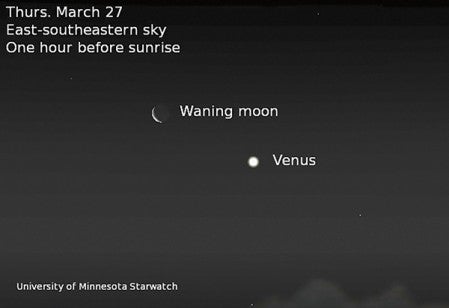Mars on the move
Published 11:32 pm Saturday, March 1, 2014

By Deane Morrison
University of Minnesota
This is a new feature from the University of Minnesota that will run in the Austin Daily Herald’s Spotlight section once a month, featuring guidance on where to turn our eyes to gaze upon the stars.
Mars is on the march this March.
In early April, Earth overtakes Mars in the race around the sun, and during March our two planets come 15 million miles closer. As Earth gains on it, we see Mars brightening and coming up over the eastern horizon earlier each night.
The Red Planet begins March rising just over three hours after sunset and ends the month rising only an hour afterward. It travels the night sky in company with the bright star Spica, in Virgo.
Saturn trails Mars by about two and a half hours. The ringed planet is in Libra, between Virgo and Scorpius. Earth catches up to Saturn in May, so we don’t have to wait too long to see it, too, in its glory.
Jupiter still dominates the winter constellations as they make their way toward their seasonal oblivion in the west. East of these bright stars and west of bright Regulus, in Leo, look for the faint, beautiful Beehive star cluster. Its Latin name is Praesepe, the manger. Framing the cluster are two stars called the Aselli, or asses, feeding at the manger.
The Beehive is an example of an open cluster, where the stars were all born from the same cloud of gas and are still loosely bound to each other gravitationally. To see it, wait for a moonless night and use binoculars.
A morning “star,” Venus rises about two hours ahead of the sun. Our sister planet is leaving us behind as it heads away toward the far side of the sun, but it’s still a very pretty ornament in the eastern predawn sky.
March’s full moon arrives on the 16th at midday. It will be visible before setting that morning, and after rising in twilight that evening. Algonquin Indians called this moon by many names: full worm moon, for the reappearance of worms in the softening earth; full crow moon, for the cawing of the birds near winter’s end; full crust moon, for the crust that forms on snow after melting and refreezing; and the full sap moon, as this is the season for maple sugaring.
Spring arrives at 11:57 a.m. on the 20th, when the sun crosses the equator heading north. At that moment Earth’s sunward side will be lighted from pole to pole.
In astronomy news, University of Minnesota astrophysicists are leading the study of a tiny galaxy they helped discover right in the sun’s back yard.
It’s called Leo P (the P is for pristine), and it’s only about 4 percent as wide as our Milky Way galaxy. It is considered quite a find, because its chemical composition is believed to mirror what existed five minutes after the Big Bang. This makes it an invaluable “time capsule” for studying how the Big Bang unfolded. You can see a picture of Leo P and read more by going to the U of M website, www.umn.edu, and searching for “Leo P.”
The University of Minnesota offers public viewings of the night sky at its Duluth and Twin Cities campuses. For more information and viewing schedules, see: Duluth, Marshall W. Alworth Planetarium: www.d.umn.edu/planet Twin Cities, Minnesota Institute for Astrophysics (during fall and spring semesters): www.astro.umn.edu/outreach/pubnight. Check out the astronomy programs at the University of Minnesota’s Bell Museum ExploraDome: www.bellmuseum.umn.edu/ForGroups/ExploraDome/index.htm.
Contact: Deane Morrison, University Relations, (612) 624-2346,morri029@umn.edu Find U of M astronomers and links to the world of astronomy athttp://www.astro.umn.edu.

